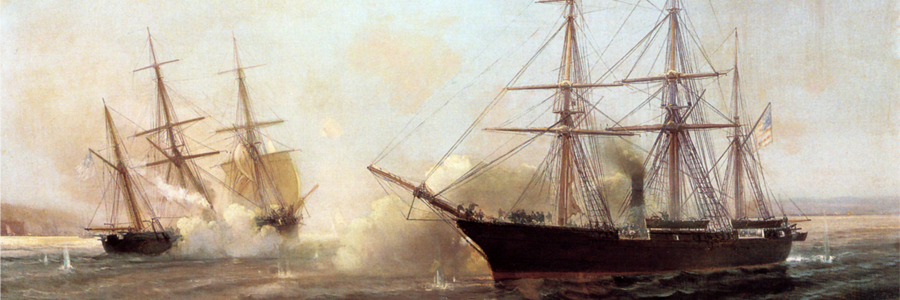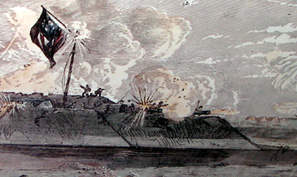
Hatteras Visitor Center Hours
Located at the Cape Hatteras Lighthouse
Friday of Memorial Day weekend through Labor Day
Hours: 9 a.m. to 6 p.m.
The rest of the year (closed Christmas Day)
9 a.m. to 5 p.m
Currently There are only mounuments and markers of past forts and batteries at Hatteras Inlet.
Roanoke Island
Although Roanoke Island was the site of one of the largest battles in the state, today there is no physical evidence of the fight. The fall of Roanoke Island, however, is remembered on the island for another notable reason: it became a haven for escaped and freed slaves who sought the protection of the occupying Union army. By 1863, nearly 3,000 freedmen had settled on the island and established the first Freedman's Colony of the war.
Albemarle Sound
The Battle of the Hatteras Inlet Batteries August 28-29, 1861:
The Battle of Hatteras Inlet Batteries, sometimes known as the Battle of Forts Hatteras and Clark, was a small but significant engagement in the early days of the American Civil War. Two Confederate forts on the North Carolina Outer Banks were subjected to an amphibious assault by Union forces that began on 28 August 1861. The ill-equipped and undermanned forts were forced to endure bombardment by seven Union warships, to which they were unable to reply. Although casualties were light, the defenders chose not to continue the one-sided contest, and on the second day they surrendered. As immediate results of the battle, Confederate interference with Northern maritime commerce was considerably reduced, while the Union blockade of Southern ports was extended. More importantly, the Federal government gained entry into the North Carolina Sounds. Several North Carolina cities (New Bern, Washington, Elizabeth City, and Edenton among them) were directly threatened. In addition, the sounds were a back door to the Confederate-held parts of Tidewater Virginia, particularly Norfolk.
The battle is significant for several reasons: It was the first notable Union victory of the war; following the embarrassment of First Bull Run (or First Manassas), 21 July 1861, it encouraged supporters of the Union in the gloomy early days. It represented the first application of the naval blockading strategy. It was the first amphibious operation, as well as the first combined operation, involving units of both the United States Army and Navy. Finally, a new tactic was exploited by the bombarding fleet; by keeping in motion, they did much to eliminate the traditional advantage of shore-based guns over those carried on ships
Roanoke Island - February 7-8, 1862
The opening phase of what came to be called the Burnside Expedition, the Battle of Roanoke Island was an amphibious operation of the American Civil War, fought on February 7–8, 1862, in the North Carolina Sounds a short distance south of the Virginia border. The attacking force consisted of a flotilla of gunboats of the Union Navy drawn from the North Atlantic Blockading Squadron, commanded by Flag Officer Louis M. Goldsborough, a separate group of gunboats under Union Army control, and an army division led by Brig. Gen. Ambrose E. Burnside. The defenders were a group of gunboats from the Confederate States Navy, termed the Mosquito Fleet, under Capt. William F. Lynch, and about 2,000 Confederate soldiers commanded locally by Brig. Gen. Henry A. Wise. The defense was augmented by four forts facing on the water approaches to the island, and two outlying batteries. At the time of the battle, Wise was hospitalized, so leadership fell to his second in command, Col. Henry M. Shaw.
During the first day of the battle, the Federal gunboats and the forts on shore engaged in a gun battle, with occasional contributions from the Mosquito Fleet. Late in the day, Burnside's soldiers went ashore unopposed; they were accompanied by six howitzers manned by sailors. As it was too late to fight, the invaders went into camp for the night.
On the second day, February 8, the Union soldiers advanced but were stopped by an artillery battery and accompanying infantry in the center of the island. Although the Confederates thought that their line was safely anchored in impenetrable swamps, they were flanked on both sides and their soldiers were driven back to refuge in the forts. The forts were taken in reverse. With no way for his men to escape, Col. Shaw surrendered to avoid pointless bloodshed.
South Mills - April 19, 1862
The Battle of South Mills, also known as the Battle of Camden, took place on April 19, 1862 in Camden County, North Carolina as part of Union Army General Ambrose E. Burnside's North Carolina expedition during the American Civil War.
Learning that the Confederates were building ironclads at Norfolk, Burnside planned an expedition to destroy the Dismal Swamp Canal locks to prevent transfer of the ships to Albemarle Sound. He entrusted the operation to Brig. Gen. Jesse L. Reno's command, which embarked on transports from Roanoke Island on April 18. By midnight, the convoy reached Elizabeth City and began disembarking troops. On the morning of April 19, Reno marched north on the road to South Mills. At the crossroads a few miles below South Mills, elements of Col. Ambrose R. Wright's command delayed the Federals until dark. Reno abandoned the expedition and withdrew during the night to the transports at Elizabeth City. The transports carried Reno's troops to New Bern where they arrived on April 22.

